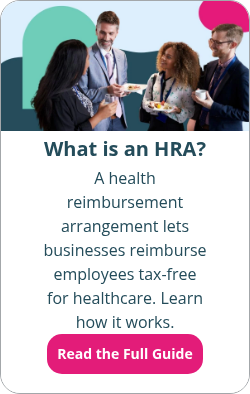Types of employee reimbursements
By Chase Charaba on October 15, 2024 at 8:00 AM
Most organizations occasionally need to reimburse employees for their out-of-pocket expenses. As an employer, it's important to understand the different types of employee reimbursements since your team may have to front the cost of items like office supplies, travel, and health benefits. You also have to know how to manage them.
In this article, we'll cover four key types of employee reimbursements: business expenses, auto mileage and travel, medical expenses, and employee stipends.
In this blog post, you'll learn the following:
- How reimbursements can cover employee business expenses including cover travel, training, supplies, tools, and other work-related costs.
- What it takes for a business expense to qualify as tax-deductible and be received tax-free by the employee.
- Which states require employers to cover certain business expenses.
What is a reimbursement?
Before diving into the types of employee reimbursements you may encounter, let’s define the concept of reimbursement. A reimbursement is a repayment made to an individual who covered an expense on your behalf.
Employers may need to reimburse their employees in a few key situations. For instance, an employee reimbursement would need to be issued if an employee purchased supplies for their office. In another case, an employer may offer a health benefit that reimburses employees for incurred medical costs, instead of purchasing a traditional group policy (more on this later).
Business expense reimbursement
First up, let's talk about business expense reimbursements. These are payments from employers to employees for work-related expenses. But what exactly counts as employee business expenses?
According to the IRS, reimbursable expenses may include the following:
- Work-related travel costs
- Education or training
- Business supplies
- Business tools
- Miscellaneous business-related expenses
Business owners can reimburse employees for any expenses if they include those reimbursements as taxable income. However, some reimbursements can be made tax-free if the expenses they’re covering meet special rules.
Tax-deductible business expense reimbursements
Some reimbursements for business expenses are tax-deductible. For the reimbursement to qualify as tax-deductible for the business and tax-free for employees, it needs to meet the criteria1 of an accountable plan.
An accountable plan must meet the following IRS guidelines:
- The expenses it covers must have a business connection. Employees must have paid for or incurred expenses while performing services for the organization. The expenditure must be related to their job.
- The employee must adequately account for these expenses within a reasonable period. Receipts need to verify the date, time, place, amount, and what the business expense was for. The IRS defines a reasonable period of time as 60 days after the employee pays the expense. However, they do consider individual circumstances.
- The employee must return any excess reimbursement or allowance within a reasonable period, usually 120 days. For example, suppose an employer provides an employee with $20 to purchase office supplies, and the actual expense is $17. In that case, the employee must return the $3 to the organization.
As long as the expense and reimbursement meet these guidelines, you don't have to list the reimbursement on your employee's Form W-2s. However, if your reimbursement doesn't meet the rules for an accountable plan, you should report it on your employee's Form W-2.
Under the Fair Labor Standards Act (FLSA), you don’t have to reimburse employees for expenses as long as it doesn't reduce an employee's wage below minimum wage. But, many states have laws requiring employers to reimburse business expenses2.
Other states, such as California, require employers to reimburse their employees for their remote work expenses. This can include internet access costs, cell phone bills, and other tools needed for remote workers to do their jobs.
Auto mileage and travel reimbursement
Another type of reimbursable expense category is auto mileage and travel costs. Technically, these are types of business expense reimbursements. However, some specific characteristics of travel reimbursement set it apart from the other types.
Standard mileage rates
Mileage rates are a way to reimburse employees for gas and wear and tear on their vehicles. Most businesses use the standard federal mileage rates3, also known as cents per mile, when reimbursing employees for personal transportation expenses.
The IRS sets standard mileage rates yearly to help employers determine the deductible costs of operating a vehicle. For 2024, the standard mileage rate is $0.67 per mile driven for business use.
Per diem rates
Employers can offer a fixed per diem rate for meal expenses, incidental travel expenses, and lodging expenses (excluding taxes).
Employers can use this as a “maximum reimbursement amount” and gather and track receipts. They can also assume expenses will reach this amount and reimburse the employee the entire amount, whether they use it or not. This avoids the hassle of tracking the expenses.
The General Services Administration (GSA) establishes per diem rates4 every October for different regions within the U.S.
Medical expense reimbursement
Medical expense reimbursement plans (MERPs) are another type of employee reimbursement. Reimbursing medical expenses is an alternate way for employers to offer employees health benefits instead of traditional group health plans. They are also known as Section 105 plans.
One type of MERP, a health reimbursement arrangement (HRA), is an increasingly popular health benefit for small employers in particular. According to our 2024 Employee Benefits Survey, 92% of employees rated health benefits as important, but many small employers struggle to find a health benefit that fits their team or budget.
With an HRA, you can offer your employees a quality health benefit that allows them to choose the individual health insurance coverage they prefer. You also empower your employees by giving them the freedom to choose which expenses they want to get reimbursed for, all while you maintain complete cost control.
There are three popular types of HRAs that we'll explore below.
Qualified small employer HRA (QSEHRA)
A qualified small employer HRA (QSEHRA) allows employers to set a monthly or annual allowance to reimburse eligible employees tax-free for individual health insurance premiums and other qualified healthcare expenses. Only employers with fewer than 50 full-time equivalent employees (FTEs) who don't offer a group plan can offer a QSEHRA.
They are simple to deploy and manage and have maximum contribution limits, which the IRS adjusts every year. Reimbursements are free of payroll tax (FICA) for the employer and employee and free of income tax for the employee. Employees must have insurance that qualifies as minimum essential coverage (MEC) to participate.
Individual coverage HRA (ICHRA)
Individual coverage HRAs (ICHRAs) give employers much more flexibility than QSEHRAs. Employers of any size can offer it, and there are no contribution limits. To participate, employees must have individual health insurance coverage with MEC, which they can pay for through ICHRA reimbursements.
ICHRAs enable employers to set different reimbursement amounts for employees based on their job classification (full-time employees, part-time, salaried, hourly, seasonal, etc.). Unlike QSEHRAs, you can offer a traditional group health plan to classes of employees you don't offer an ICHRA.
Group coverage HRA (GCHRA)
Unlike ICHRAs and QSEHRAs, a group coverage HRA (GCHRA), also called an integrated HRA, allows employers to reimburse employees on a traditional group health plan for expenses their plan doesn't cover or fully pay for. It's tax-free and gives you more control over your health benefit costs.
Employers find GCHRAs are a great way to make high deductible plans work well for employees and create top-tier luxury health benefits to attract top talent.
Employee stipends reimbursement
The final employee reimbursement type we'll discuss is employee stipends. Employee stipends are a flexible way to provide additional benefits and perks to your organization to help attract and retain top talent.
Stipends allow you to set monthly allowances for your employees that cover specific perks that your team values. With most stipends, employers offer an allowance up-front and allow employees to use it to buy what they want. But, employers can set them up as reimbursement plans. Employees submit reimbursement requests with their expenses for approval.
Let's break down the most popular types of employee stipends.
Health stipends
A health stipend reimburses employees for their qualifying medical expenses. It works similarly to an HRA, except it’s not considered a formal health benefit and is therefore taxable.
Health stipends are best for businesses with employees who receive premium tax credits. Employees don't have to waive their credits to use the stipend like they would with an HRA. They’re also an excellent option for businesses with group health insurance that want to give employees an allowance for individual dental or vision insurance premiums or mental health benefits not fully covered in the group plan.
Some expenses you can reimburse under a health stipend include:
- Insurance premiums
- Prescriptions
- Chiropractic care
- Out-of-pocket medical expenses
You can also reimburse employees for any type of health expense that you'd like. For example, you could also allow your employees to use their health stipend for mental health apps, gym memberships, or anything else.
But, a stipend doesn't satisfy the Affordable Care Act's employer mandate for organizations with 50 or more FTEs. Larger organizations must offer a group plan or an HRA instead to maintain compliance.
You also can’t ask employees for proof of insurance or for receipts for any items listed in IRS Publication 502 to prove that they used their stipend toward an eligible health expense.
Wellness stipends
Wellness stipends reimburse employees for general wellness expenses that aren’t categorized as medical expenses. They work the same way as a health stipend, where employees receive a monthly allowance. Employees can then request reimbursement for wellness expenses.
Common examples of reimbursable expenses with a wellness stipend are:
- Gym memberships
- Fitness classes
- Exercise equipment
- Meditation apps
- Fitness trackers
Wellness stipends can improve employee retention and improve their overall health, keeping them engaged and productive on the job.
Remote work stipends
A remote work stipend is an allowance provided to employees to reimburse their home office expenses. Unlike reimbursements for business expenses, which must meet IRS accountable plan requirements to be tax-free, remote work stipends are taxable. This means you can offer it for a broader range of home office expenses.
With many people working from home, offering a remote work stipend is a great perk. It can help your employees pay for their internet bills, as they'll be using much of their bandwidth for work purposes. You can also reimburse employees for their phone bills if they use their phones for work, among other expenses such as software subscriptions, technology, and materials.
Remember that list of states that require employers to reimburse employees for business expenses? That may also include remote work expenses. Offering a remote work stipend is a great way to satisfy these state laws while helping to support your remote workforce.
Education stipends
You can also use stipends to pay for employees' education-related expenses. This can include the reimbursement of tuition payments, student loans, textbooks, and other professional development expenses.
Education assistance is an IRS-approved tax-free fringe benefit of up to $5,250 per employee per year. This includes tuition reimbursement, continuing education courses, student loan repayment, and more. You can also reimburse employees for more expenses than the federal limit. However, any excess reimbursements are taxable wages.
Thanks to the SECURE 2.0 Act, 401(k) sponsors and 403(b) sponsors can also provide matching contributions for employee student loan payments
With an employee stipend, you can provide a flat monthly allowance for your employees' education expenses or choose to only reimburse for certain categories, such as student loan repayment. Then, they can request reimbursement for whichever expense works best for them.
Conclusion
Companies pay back employees for several different out-of-pocket costs, such as office supplies, meals, medical care, and travel incurred during work. Depending on the type of expense and how employers handle these reimbursements, many of them can even have tax benefits.
No matter how you decide to reimburse employees, you'll want to create a formal expense reimbursement process so that employees know how and when they can expect to receive their money.
If you're looking to bolster your benefits offerings by leveraging a reimbursement-style health benefit, PeopleKeep can help. With our HRA administration platform, you can set up and manage a reimbursable, defined-contribution health benefit in just minutes each month.
This blog article was originally published on December 22, 2014. It was last updated on October 15, 2024.
2. SHRM
Check out more resources
See these related articles

Health insurance reimbursements: What are the options?
Explore your options for health insurance reimbursement. Understand what insurance reimbursement means and how HRAs can support employees.

Can I reimburse employees for health insurance?
Learn about the two most common ways to compliantly reimburse employees for their healthcare: taxable stipends and health reimbursement arrangements (HRA).

What is healthcare reimbursement?
Looking to reimburse your employees for their healthcare expenses? Learn everything you need to know about healthcare reimbursement.



